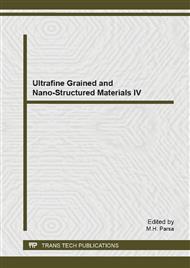[1]
M. Mehrabian, R. Azimirad, K. Mirabbaszadeh, H. Afarideh, M. Davoudian, UV detecting properties of hydrothermal synthesized ZnO nanorods, Physica E 43 (2011) 1141-1145.
DOI: 10.1016/j.physe.2011.01.030
Google Scholar
[2]
S.S. Shinde, K.Y. Rajpure, Fast response ultraviolet Ga-doped ZnO based photoconductive detector, Materials research bulletin, Materials Research Bulletin 46 (2011) 1734–1737.
DOI: 10.1016/j.materresbull.2011.05.032
Google Scholar
[3]
D. Shao, S. Sawyer, T. Hu, M. Yu, J, Lian, Photoconductive enhancement effects of graphene quantum dots on ZnO nanoparticle photodetectors, Lester Eastman Conference on High Performance Devices (LEC), 1 (2012) 7-9.
DOI: 10.1109/lec.2012.6410972
Google Scholar
[4]
J. Chang, C. Najeeb, J. Lee, M. Lee and J. Kim, High-performance photoresponse from single-walled carbon nanotube–zinc oxide heterojunctions, J. Phys. D: Appl. Phys. 44 (2011) 095101.
DOI: 10.1088/0022-3727/44/9/095101
Google Scholar
[5]
H.Y. Yang, D.I. Son, T.W. Kim, J.M. Lee, W.I. Park, Enhancement of the photocurrent in ultraviolet photodetectors fabricated utilizing hybrid polymer-ZnO quantum dot nanocomposites due to an embedded graphene layer. Organic Electronics, 11 (2010).
DOI: 10.1016/j.orgel.2010.04.009
Google Scholar
[6]
O. Akhavan, E. Ghaderi, Toxicity of graphene and graphene oxide nanowalls against bacteria. ACS nano, 4 (2010) 5731-5736.
DOI: 10.1021/nn101390x
Google Scholar
[7]
Z.L. Wang, D. Xu, Y. Huang, et al. Facile, mild and fast thermal-decomposition reduction of graphene oxide in air and its application in high-performance lithium batteries. Chemical Communications 48. 7 (2012) 976-978.
DOI: 10.1039/c2cc16239c
Google Scholar
[8]
J. Tauc, Optical properties and electronic structure of amorphous Ge and Si. Materials Research Bulletin 3 (1968) 37-46.
DOI: 10.1016/0025-5408(68)90023-8
Google Scholar
[9]
O. Akhavan, R. Azimirad, S. Safa, Functionalized carbon nanotubes in ZnO thin films for photoinactivation of bacteria. Materials Chemistry and Physics, 130 (2011) 598-602.
DOI: 10.1016/j.matchemphys.2011.07.030
Google Scholar
[10]
H. Kim, H. Park, H. Jeon, H.J. Chang, Y. Chang, H.H. Park, Incorporation of carbon nanotube into direct-patternable ZnO thin film formed by photochemical solution deposition. Ceramics International, 35 (2009) 131-135.
DOI: 10.1016/j.ceramint.2007.10.029
Google Scholar
[11]
Y. Zhu, H.I. Elim, Y.L. Foo, T. Yu, Y. Liu, W. Ji, .. & C.H. Sow, Multiwalled carbon nanotubes beaded with ZnO nanoparticles for ultrafast nonlinear optical switching. Advanced Materials, 18 (2006) 587-592.
DOI: 10.1002/adma.200501918
Google Scholar
[12]
Z. L. Wang, D. Xu, Y. Huang, Z. Wu, L.M. Wang, X.B. Zhang, Facile, mild and fast thermal-decomposition reduction of graphene oxide in air and its application in high-performance lithium batteries Chemical Communications, 48 (2012) 976-978.
DOI: 10.1039/c2cc16239c
Google Scholar
[13]
O. Akhavan, R. Azimirad, S. Safa, M.M. Larijani, Visible light photo-induced antibacterial activity of CNT–doped TiO2 thin films with various CNT contents. Journal of Materials Chemistry, 20 (2010) 7386-7392.
DOI: 10.1039/c0jm00543f
Google Scholar
[14]
S. Watcharotone, D.A. Dikin, S. Stankovich, R. Piner, I. Jung, G. HB Dommett, G. Evmenenko et al. Graphene−Silica Composite Thin Films as Transparent Conductors, Nano letters 7 (2007) 1888-1892.
DOI: 10.1021/nl070477+
Google Scholar



